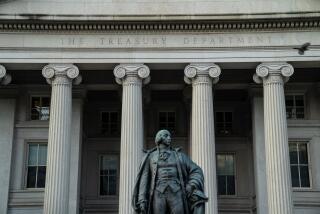Fed’s lifeline to Main Street flops: 99.8% of cash remains untapped

- Share via
It was billed as a lifeline for America’s middle-market companies seeking cash to get through the pandemic. Yet more than two months after its launch, the Federal Reserve’s Main Street Lending Program isn’t living up to expectations, as few banks are willing to provide the loans.
Some of the nation’s biggest lenders have demanded such crushing terms that discussions have stalled from the get-go, while other banks have decided not to participate at all. That’s meant the take-up for the $600-billion program is just 0.2%, threatening to undercut the economic recovery and efforts to protect jobs.
Data analytics firm IDM is among hundreds of midsize businesses affected by COVID-19 that have been left disappointed.
It was hoping to get a Fed-assisted loan to support payroll, refinance debt and potentially hire more employees. What the Reston, Va., company found instead were banks in West Virginia and Georgia that weren’t taking part, and it wasn’t able to pursue a loan with JPMorgan Chase & Co. because the firm was asked to pledge real estate it doesn’t have.
“We can’t even get out of the box and submit an application,” said John Chung, chief operating officer at IDM, which has $30 million in annual revenue. “This whole thing is kind of a joke.”
Companies slammed by the pandemic — and even resilient ones — have struggled to find banks willing to lend through the program. Cardinal Capital, a Baton Rouge, La., commercial finance brokerage firm, has been looking to borrow about $300 million for various clients. But most of the 60 banks it approached won’t accept new borrowers, nor will they work with new businesses backed by assets that fall outside the lender’s usual purview, the company’s partner Rob Powell said.
JPMorgan, meanwhile, has had discussions with about 2,000 of its clients about Main Street loans, but received applications from only about 5% of them, according to a person familiar with the matter who wasn’t authorized to speak publicly. JPMorgan spokeswoman Ashley Frost declined to comment.
The Fed and Treasury Department started the program July 6 with the aim of providing loans to companies either too small to access capital markets or too big to get aid through the government’s Paycheck Protection Program.
Just $1.4 billion of Main Street loans had been issued as of Sept. 10, with an additional $300 million or so submitted or being processed, according to the Boston Fed, which administers the program. In contrast, blue-chip companies have sold more than $1.2 trillion of corporate bonds since March to help weather the pandemic’s economic effects, and smaller outfits have benefited from hundreds of billions of dollars in potentially forgivable loans.
The government “essentially set up a program that didn’t do what the mandate was, which was to protect jobs, to get the funds readily available to businesses — particularly businesses who were not able to benefit from the PPP,” said Tom Bohn, chief executive of the Assn. for Corporate Growth, which represents middle-market companies and their lenders.
What’s worrisome is that midsize companies employ about 48 million people and account for about a third of the gross domestic product in the private sector. A credit crunch for such companies could cause many to limp along or fail, undermining a post-pandemic recovery. Critics of the program have included Rep. James Clyburn (D-S.C.) and Bharat Ramamurti, a member of the Congressional Oversight Commission for the CARES Act.
Among lender concerns in the program’s current state are capital charges they have to account for because of the requirement to hold 5% of the loans. Some also lack expertise after stepping back from lending to riskier middle-market companies after the last financial crisis a decade ago. And there are also questions around how potential bankruptcies would work, spooking would-be lenders fearful of facing off in court against the Fed, said Ellen Snare, a partner at law firm King & Spalding.
The Treasury itself has advised banks to avoid taking any credit risk — a key component of lending, telling them to target zero losses, according to bankers interviewed by Bloomberg.
The Fed has already tweaked the program a few times, and regulators are looking at additional adjustments to address some of the issues. Some economists have suggested the Fed take on greater credit risk, with banks employed simply to process the loans. Other ideas put forth are offering government subsidies to lower the cost of borrowing, placing banks ahead of the government in bankruptcy workouts and shifting to more equity-like financings.
Still, only 575 lenders had said they’d participate by Sept. 4, and most of them have yet to hand out loans. One lender, City National Bank of Florida, accounts for 50% of disclosed loans and 30% of the total amount borrowed, according to the Fed.
Treasury Secretary Steven T. Mnuchin said at a Sept. 1 congressional hearing that loan issuance could grow to $25 billion to $50 billion, predicting a lot of volume in the next two months. That increase, even if it does happen, would still represent only 4% to 8% of the program’s maximum size. The Fed is likely to be asked about the program at its meeting Wednesday.
Treasury Department representatives declined to comment further, as did the Federal Reserve.
All told, access to credit for small and midsize companies may get worse. Already, large and regional banks are offering fewer loans of $25 million or less, according to AFS Business Intelligence, and a survey of senior lending officers indicates that lending conditions are tightening at the quickest pace since the financial crisis.
“I am not sure the verdict on Main Street is fully in yet,” said Jeremy Stein, chairman of the Harvard University economics department and a Fed governor from 2012 to 2014. “But I do think it will be a problem if the economy continues to suffer, corporate bankruptcies go up and the program still has little take-up.”
Lee, Saraiva and Davis write for Bloomberg.
More to Read
Inside the business of entertainment
The Wide Shot brings you news, analysis and insights on everything from streaming wars to production — and what it all means for the future.
You may occasionally receive promotional content from the Los Angeles Times.










